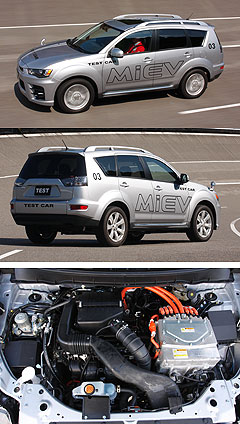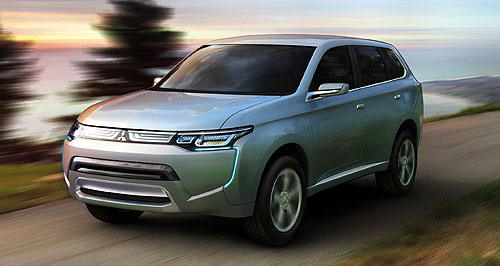Future models - Mitsubishi - Outlander - Plug-in hybridFirst drive: Plug-in Outlander redefines SUVUnplugged: A plug-in hybrid version of the next-generation Mitsubishi Outlander - previewed by the PX-MiEV concept - will debut within two years. Mitsubishi previews next-gen SUV with EV and range-extender capability6 Dec 2011 By BYRON MATHIOUDAKIS in TOKYO MITSUBISHI is set to deliver its first plug-in hybrid SUV inside two years, as previewed by the PX-MiEV II concept vehicle at last week’s Tokyo motor show. The powertrain is destined for the next Outlander not long after the conventional petrol and diesel versions debut Down Under in late 2012. Mitsubishi Motor Corporation general manager of design Hiroaki Ohtsuka said the concept’s styling was about 70 per cent production-reality, adding that the current Outlander’s trapezoidal grille would be discarded because “it gives the impression that it takes in a lot of air and eats a lot of gasoline”. No pricing details have been divulged, except that over the longer-term but certainly not initially, Mitsubishi aims to charge a “small premium” over an equivalently priced diesel version. The productionised PX-MiEV will be part of the corporation’s plan to release eight new pure EV and PHEV models by 2015, to help it slash carbon-dioxide emissions over 2005 levels by 25 per cent. However, the PX-MiEV II is not strictly a pure EV even though it operates like one for most of the time, as Mitsubishi strives to increase its appeal on an ambitious global scale by targeting family and fleet car buyers who require a vehicle that can go ‘beyond the city limits’ without range anxiety. This essentially is an SUV with two electric motors (called Twin Motor), one petrol engine, a generator, lithium-ion battery pack and all-wheel drive. There are three operation modes:  Left: PX-MiEV test mule. Left: PX-MiEV test mule.EV – when two 60kW permanent magnet synchronous electric motors (front and rear) drive all four wheels independently according to conditions for zero emissions up to 50km or more. Series hybrid – using a 70kW 2.0-litre MIVEC four-cylinder internal combustion petrol engine to regenerate the batteries on the move once charge levels drop below a certain point, range-extender style. Parallel hybrid – whereby the petrol engine drives the front wheels with or without help from the electric motors at higher speeds or when strong acceleration is required. MMC has not released total power or torque outputs, although we believe at least 200Nm is available. Acceleration is said to be on a par with a 3.0-litre V6 petrol engine. Chosen as the ideal capacity for optimum economy, the 2.0-litre MIVEC unit at most supplements the electric motors in parallel hybrid mode, so a single-speed ratio is used that approximates fifth gear in the regular petrol-powered Outlander, and only operates between 2500 and 5500rpm according to prevailing conditions. Similarly, when merely charging in Series Hybrid mode, it is spins at about 3000rpm. The PX-MiEV II features three cooling systems – for the motors, engine, and battery pack. Total range in EV mode is “more than” 50km while top speed is 100km/h. In series hybrid mode, more than 800km of range while 180km/h-plus are possible, while 1.66 litres per 100km is the Japanese combined fuel efficiency cycle. At urban speeds, drivers can manually select EV-only mode, provided there’s enough charge, but the PX-MiEV II will revert to series hybrid and even parallel hybrid modes should extra power and/or speed be required. Additionally, based on driver preferences, there’s a console-mounted selector for eco, normal and power modes, with the middle one providing “an optimal balance of motive power and environmental performance”, according to Mitsubishi. The all wheel control traction system is similar to that introduced in the Lancer Evolution X, and relies on the Twin Motor’s AWD set-up to provide extra stability for improved manoeuvrability. Plugging into either a regular 230V outlet or a fast charge service means an eight and 4.5 hours wait respectively, while the battery can store electricity to redistribute into the grid or generate it as an AC power source when in remote areas, for example. Speaking of distribution, the battery pack’s low centre of gravity between the axles, combined with the rear-mounted motor, allows for a 52:48 front-to-rear weight balance. Key details, such as fuel tank capacity, motor supplier information, fuel consumption and carbon dioxide emissions figures, and total weight of the electrification equipment compared to the regular internal combustion Outlanders, are yet to be released or confirmed by MMC. The PX-MiEV II concept vehicle is roughly the same size as the current ZH Outlander, with a 4660mm length, 1830mm width and 1680mm height. One MMC engineer revealed that the next-generation platform would employ a variation of the existing GS item that is also shared with the Lancer and ASX SUV in Australia. As a result, we can expect PHEV tech to trickle down to the Outlander’s smaller siblings over time. Armed with all this knowledge, the numerous laps at MMC’s Okazaki Test Track in Japan revealed a very production-ready PX-MiEV II drivetrain, despite the 2006-era clothes worn by the Outlander prototypes. Start-up is silent, as is the seamless surge forward in the first part of the test, involving 40 to 80km/h short bursts for an extended period. As we’ve come to expect driving EVs lately, only the rising turbine rush really betrays the electrification going on underneath, as well as the more noticeable wind and tyre noise that would otherwise have been drowned out by a normal internal combustion engine. For refinement and low noise (as well as CO2) pollution, there is no better way right now. If we continued to do that all day, the Series Hybrid part of the PX-MiEV II would eventually kick in at a constant 3000rpm to help generate electricity to the battery pack – but we didn’t hang around for that. Instead, we ventured on to the test track’s banked circuit, and after the quietness of pure EV motoring, the 2.0-litre MIVEC engine made itself heard once we put our foot down. Still, with a potential 800km of range on offer between fuel stops, it isn’t too loud or intrusive, while the transition from EV to hybrid seemed effortless. Though we were limited to 120km/h, a few brief spells at 135km/h finally meant the petrol engine was supplying the front wheels as well as the battery pack. This subtly altered the PX-MiEV II’s character: while still swift, with plenty of power left in reserve for rapid acceleration, it felt more stable and surefooted, with greater steering resistance. But as this is far from the most efficient method of operation, we soon backed off. MMC insisted we not try sharp manoeuvres as the pair of prototypes featured incomplete states of steering and suspension tuning, but the brakes did not feel as wooden as those on so many EVs, despite the presence of regenerative braking, while the car seemed reasonably composed on the high-speed embankment. However, the Outlander also felt heavy and solid on the road, making us wonder how many more kilos all that electrification adds. Obviously, as per usual with these things, we needed more time, across a far greater variety of roads, to properly assess what’s on offer. And of course there was no way of sensing the next-generation Outlander’s character since everything we could see and touch pertained to the existing model. Yet the PX-MiEV II impresses thoroughly with its fresh, easy, comfortable and flowing character oozing from within the floor, changing from zippy zero emission EV to worry-free hybrid SUV with total smoothness. And while many questions remain – especially the all-important one on price – clearly Mitsubishi is deadly serious about trailblazing yet another sort of eco vehicle in this country. Come 2013, when the PX-MiEV II Tokyo concept body meets the Okazaki Test Track prototype underpinnings, we’ll be blazing a trail to Mitsubishi to try out the real thing.  Read more |
Click to shareMotor industry news |
















Facebook Twitter Instagram